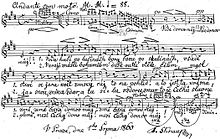Kde_domov_můj?
"Kde domov můj" (pronounced [ɡdɛ ˈdomof muːj] ⓘ; English: "Where My Home Is") is the national anthem of the Czech Republic, written by the composer František Škroup and the playwright Josef Kajetán Tyl.[1]
This article needs additional citations for verification. (December 2017) |
| English: Where My Home Is | |
|---|---|
 Škroup’s score of the original song | |
National anthem of the Czech Republic Former co-national anthem of Czechoslovakia | |
| Lyrics | Josef Kajetán Tyl, 1834 |
| Music | František Škroup, 1834 |
| Adopted | 1918 |
| Readopted | 1990 |
| Audio sample | |
2008 official orchestral and vocal recording by the Prague National Theatre Orchestra and Choir | |

Problems playing this file? See media help.
The piece was written as a part of the incidental music to the comedy Fidlovačka aneb Žádný hněv a žádná rvačka (Fidlovačka, or No Anger and No Brawl). It was first performed by Karel Strakatý at the Estates Theatre in Prague on 21 December 1834. The original song consists of two verses (see below). Although J. K. Tyl is said to have considered leaving the song out of the play, not convinced of its quality, it soon became very popular among Czechs and was accepted as an informal anthem of a nation seeking to revive its identity within the Habsburg monarchy.
Soon after Czechoslovakia was formed in 1918, the first verse of the song became the Czech part of the national anthem, followed by the first verse of the Slovak song "Nad Tatrou sa blýska". The songs reflected the two nations' concerns in the 19th century[2][page needed] when they were confronted with the already fervent national-ethnic activism of the Germans and the Hungarians, their fellow ethnic groups in the Habsburg Monarchy. Because of the linguistic and ethnic diversity of the First Republic, official translations were made into Hungarian and German as well.[3][page needed]
With the split of Czechoslovakia in December 1992, the Czech Republic kept Kde domov můj and Slovakia kept Nad Tatrou sa blýska as their anthems. While Slovakia extended its anthem by adding a second verse, the Czech Republic's national anthem was adopted unextended, in its single-verse version.[1]
In 1882, Antonín Dvořák used Kde domov můj in his incidental music to the František Ferdinand Šamberk play Josef Kajetán Tyl, Op. 62, B. 125. The overture is often played separately as a concert work entitled Domov můj (My Home).
Original lyrics (from Fidlovačka, 1834)
| Czech original | IPA transcription[lower-alpha 1] | Poetic English translation 1 |
|---|---|---|
I |
1 |
I |
National anthem of Czechoslovakia 1918–1992
Czechoslovak Republic
The first stanza, along with that of the Slovak song Nad Tatrou sa blýska which is nowadays the national anthem of Slovakia, became from 1918 to 1992 the national anthem of Czechoslovakia.
| Czech and Slovak original | IPA transcription[lower-alpha 1] | English translation |
|---|---|---|
Stanza 1 (Kde domov můj) | ||
Kde domov můj, kde domov můj, |
[ɡdɛ ˈdo.mof muːj | ɡdɛ ˈdo.mof muːj |] |
Where my home is, where my home is, |
Stanza 2 (Nad Tatrou sa blýska) | ||
Nad Tatrou sa blýska, hromy divo bijú |
[ˈnat ta.trɔʊ̯ sa ˈbliːs.ka | ˈɦrɔ.mi ˈdi.ʋɔ ˈbi.juː] |
There is lightning over the Tatras, thunders wildly beat, |
Current lyrics (adapted version)
The following are the lyrics according to Appendix 6 of Czech Act No. 3/1993 Coll., as adapted by Act No. 154/1998 Coll.
| Czech original | IPA transcription[lower-alpha 1] | Official English translation | Poetic English translation |
|---|---|---|---|
Kde domov můj, kde domov můj, |
[ɡdɛ ˈdo.mof muːj | ɡdɛ ˈdo.mof muːj |] |
Where my home is, where my home is, |
Where my home is, where my home is, |
| German translation (used 1918–1938 and 1939–1945) |
Hungarian translation (used 1920–1938) |
|---|---|
Wo ist mein Heim, mein Vaterland, |
Hol van honom, hol a hazám, |
- See Help:IPA/Czech and Czech phonology.
- "Ročník 1993 – Sbírka Zákonů České Republiky – Částka 2 – Rozeslána dne 29. prosince 1992: 3. Zákon České národní rady o státních symbolech České republiky, § 7: Státní hymna" [1993 – Collection of Laws of the Czech Republic – Section 2 – Dispatched on 29 December 1992: 3. Czech National Council Act on State Symbols of the Czech Republic, Article 7: State anthem] (PDF) (in Czech). Ministry of the Interior of the Czech Republic. 1993. Archived from the original (PDF) on 22 May 2011.
(1) Státní hymnu tvoří první sloka písně Františka Škroupa na slova Josefa Kajetána Tyla "Kde domov můj". (2) Text a notový záznam státní hymny jsou přílohou 6 tohoto zákona. [TRANS] (1) The state anthem is the first verse of the song by František Škroup with the words of Josef Kajetán Tyl "Where my home is". (2) The text and the notes of the national anthem are annex 6 of this Act.
- Auer, Stefan (2004). Liberal Nationalism in Central Europe. Routledge. ISBN 978-1-134-37860-9.
- Gössel, Gabriel; et al. (2008). Kde domov můj: státní hymna České republiky v proměnách doby [The Czech Republic's national anthem down the ages]. Government of the Czech Republic. ISBN 978-80-87041-42-0.
- Czech Republic: Kde domov můj? – Audio of the national anthem of the Czech Republic, with information and lyrics (archive link)
- State Symbols – Ministry of Foreign Affairs – The Ministry of Foreign Affairs has a page about state symbols that includes a copy of the music of the anthem.
- New (2008) official recordings – female solo, male solo, choir, and orchestral versions.